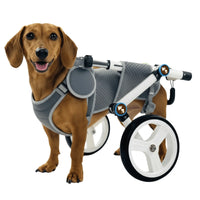
Should I Bring Water for My Dog When We Go on Walks?
Ever found yourself panting alongside your pup on a sunny stroll, both of you eyeing the nearest water fountain? It's a common scenario for dog owners. While we often remember to hydrate ourselves, it's equally crucial to consider our canine companions' hydration needs. In this article, we'll explore why bringing water for your dog during walks is essential, debunk some myths, and provide practical tips to keep your furry friend happy and healthy.
“Last summer, I forgot to bring water on Max’s walk. Five minutes in, his tongue was dragging, and he gave me that look. Never again.”
🐾 Why Hydration Matters for Dogs on Walks
Dogs, like humans, require adequate hydration to maintain their health. During walks, especially in warm weather, dogs can quickly become dehydrated due to panting and physical exertion. Dehydration in dogs can lead to serious health issues, including heatstroke, kidney problems, and even death in severe cases.
According to PetMD, dogs should have access to clean water at all times, especially during physical activities like walks. Providing water during walks helps regulate their body temperature, supports digestion, and ensures overall well-being.
🌡️ Recognizing Signs of Dehydration
It's essential to recognize the signs of dehydration in your dog to address it promptly. Common symptoms include:
- Excessive panting
- Dry nose and gums
- Lethargy or weakness
- Sunken eyes
- Loss of skin elasticity
If you notice any of these signs during or after a walk, offer your dog water immediately and consult a veterinarian if symptoms persist.
“Dogs can lose up to 10% of their body water before showing signs of dehydration,” says Dr. Susan Jeffrey, DVM, from Truesdell Animal Hospital.
According to the CDC, water quality can vary greatly depending on your location, which is why bringing your own water on dog walks is safer and more consistent for your pup.
Tips for Keeping Your Dog Hydrated on Walks

1. Carry a Portable Water Bottle
Invest in a portable dog water bottle or collapsible bowl. These are convenient for on-the-go hydration and ensure your dog has access to clean water during walks. Some bottles come with attached bowls, making it easier for your dog to drink.
2. Plan Walks During Cooler Times
Schedule walks during the early morning or late evening when temperatures are cooler. This reduces the risk of overheating and dehydration
3. Take Frequent Breaks
Allow your dog to rest and drink water every 15-20 minutes, especially during longer walks or hikes. This helps maintain hydration and prevents exhaustion.
4. Avoid Hot Surfaces
Hot pavement can increase your dog's body temperature and contribute to dehydration. Opt for grassy or shaded paths when possible.
🧪 Debunking the Colored Water Bottle Myth
You might have seen bottles filled with colored water placed around neighborhoods, believed to deter dogs from urinating in certain areas. However, there's no scientific evidence supporting this practice. Veterinarian Dr. Sean Evan Javier states that there's no proof that colored water repels dogs.
Moreover, some theories suggest that the reflection of light from the bottles might scare dogs, but these claims lack substantial research.
❓ FAQs
Q: Can my dog drink from public water sources like fountains or puddles?
A: It's best to avoid letting your dog drink from unknown water sources. Puddles and stagnant water can harbor harmful bacteria and parasites, leading to illnesses.
Q: How much water does my dog need during a walk?
A: The amount varies based on size, age, and activity level. As a general rule, offer small amounts of water every 15-20 minutes during exercise.
Q: What if my dog refuses to drink water during walks?
A: Some dogs might be hesitant to drink in unfamiliar settings. Encourage them by offering water in a familiar bowl or adding a splash of low-sodium broth to entice them.
🐶 Conclusion
Ensuring your dog stays hydrated during walks is vital for their health and happiness. By recognizing the signs of dehydration, planning appropriately, and debunking myths, you can make your walks enjoyable and safe for both you and your furry friend.
For more tips on pet care and product recommendations, check out our Dog Travel Essentials Guide.
Share



